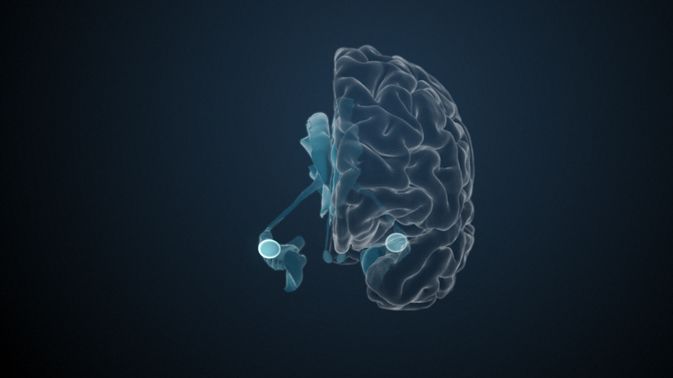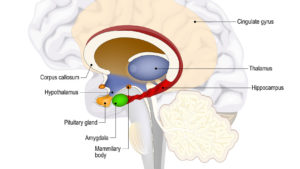Fear, or emotions, or attention?
The Amygdala is one of those brain areas that gets a lot of attention. A lot. In fact, it may be one of the most famous areas of the brain – in no short part due to its role in fear and what Daniel Goleman called the “Amygdala Hijack” to describe situations in which emotionality takes over your brain – or supposedly at least. But the amygdala is a little misrepresented – let’s clear up its reputation.

SM are the initials of a patient, who according to the case in a well-cited paper by Feinstein et al. in 2010, exhibits little to no fear. What is special about SM is that she has severe damage to both her Amygdalae. And though at the time there was known to be a strong relationship between fear and Amygdala function, SM’s rare condition enables the study of this in real world scenarios.
She was put through a series of situations and her fear measured. For example, she had consistently expressed a fear of spiders and snakes in previous interviews and so she was taken to an exotic pet store and presented with snakes and spiders to document her response. Surprisingly despite her insistence she is “afraid “ of these, she showed no fear at all. In fact, she showed the opposite: curiosity, reaching out to touch the snakes and spiders and stroke them!
In addition to this she was taken to, ostensibly, America’s most haunted house. The Waverly Hills Sanatorium Haunted House, showing no fear on a tour in contrast to other participants, and researchers, on the same tour. Her fear and emotional response were also collected systematically in everyday life with an emotional diary and through structured interviews. She indeed seemed to show no fear or to experience threat.
One notable experience also points to a key role of the Amygdala or absence of this in SM. She lived in a city and one of her walking routes home passed through a parking lot. On one occasion she was held up at knifepoint and robbed. For many this may have been a traumatic experience – but moreover it would almost certainly have led to avoiding this parking lot or walking home at night through this place. Also, the place would be expected to trigger negative memories. Not so with SM. She continued to walk across the parking lot unabated and unaffected by her negative experience there. This shows a key role of the Amygdala, and maybe underestimated with the focus on fear processing, namely that of learning.
In fact, a recent study did just this. They attempted to connect the amygdala to learning and not through triggering the emotional impact. Emotions trigger large networks in the brain and so it is difficult to disentangle the effects of different regions in the brain. In these experiments by Bass et al. in 2021 they used Deep Brain Stimulation to simulate the Amygdala (or not) in rats when encountering objects. They showed that the stimulation increased the memory of objects without observably activating emotions.

Illustration such as this are used in research into Fear – just looking at this picture consistently shows activation patterns in the amygdala.
Illustration such as this are used in research into Fear – just looking at this picture consistently shows activation patterns in the amygdala.[/caption]This puts the Amygdala at the crossroads of memory and learning and particularly Pavlovian conditioning – so relating positive or aversive stimuli with contexts. This was clearly missing in SM whose experience in the parking lot did not lead to her having aversive reactions to said parking lot. Though we have outlined this clear relationship to fear there have been just as many relationships to positive emotions and the Amygdala. This is why many researchers see it as a salience processing unit rather than a fear centre. It shows us what is important and hence where to focus our attention, or not, and what to learn or not.
However, though there is also strong activation in the Amygdala to positive or appetitive cues, cases such as in SM do not show much dysfunction of positive emotions. So, it seems the Amygdala is involved in all emotional processing, but rewarding and positive experiences rely on other networks whereas fear and threat are strongly related to, or even dependent on, the Amygdala.
This key function of the Amygdala can be seen in its location and connections: it sits in the limbic system close to the hippocampus, itself considered a memory centre, but also close to the thalamus and prefrontal cortex. It is split into different subsections, simply three. The medial, the middle bit, is connected strongly to the olfactory centres (smell), the basolateral, to the frontal and cerebral cortex, and the central & anterior to the brain stem, hypothalamus, and sensory centres.

Amygdala and neighbouring structures
All of these seem to make sense – connecting sensory input to emotional and hormone release in the hypothalamus, and to the frontal regions to control attention and close to the hippocampus to guide learning, not to mention sensory centres to build associations. Of notable interest, and little discussed is the connections to the olfactory centre. Though the majority of research is into visual stimuli, particularly of faces to which the amygdala can be more responsive than other areas of the brain supposedly specialised in faces (the FFA reviewed in lbR-2021-08).
A recent piece of research shows why – the sense of smell is one of our fastest systems to respond – harking back to a time when our sense of smell was much more important in everyday life and more than in modern society. Iravani et al. from the Karolinska Institute in Sweden showed in a recent piece of research that the olfactory system is a high-speed circuit and particularly to aversive smells which influence our avoidance behaviours. This is often also unconscious.
So, this paints a clearer picture of the function of the Amygdala as an emotional attention centre that is especially reactive and necessary for threat and aversive contexts and drives learning, memory, and conditioning. However, the role of the Amygdala may have unintentionally been tainted by Daniel Goleman’s 1995 description of the “Amygdala Hijack”. This term has been used by many an aspiring neuroleadership expert or coach.
Simply put, Goleman, at the time, painted picture whereby the amygdala reaction essentially hijacked the rational brain and rendered us at the whims of our emotionality. This is an oversimplified description which is appealing to a broader audience but does have some truth in it. Even as an aspiring neuroleadership expert I found the term a little oversimplified – however, it was also useful to describe to lay audiences how emotionality can take over the brain. The fact is, threat is a basic survival instinct and so can, and will, activate many stress systems in the body. However, how to engage and deal with this and is not clearly identified with the term amygdala hijack.
The SCOAP model that regular readers will be familiar with, goes some way to explain this in more detail – Firstly, different concepts can trigger a negative reaction (e.g. self-esteem threat but also loss of control or loss of orientation). Secondly, this can be very individualised. Thirdly, some people respond to threats much stronger than others. Fourthly, many of these are also conditioned responses. Fourthly we are looking at broad networks in the brain and body. So yes, the Amygdala hijack could be a way to describe the emotional response we have, but is too simplified to be useful and misconstrues how the amygdala and brain functions together. SCOAP is a much better way to formulate this and explore – for those who want to learn more.
But back to our two almond-shaped structures in our brain. They are widely researched, seem to have an oversized influence on brain functions, do activate strongly to threat and fear, and control response to this, and control aversive and avoidance behaviours – in fact so much so that political affiliation can be accurately predicted by looking at amygdala activation as I outline in the earlier article on fear in society.
So, the amygdala it is a powerful brain region related to primal networks – and also positive learning, and sometimes being afraid and cautious of threat is very good thing. As SM didn’t learn, sometimes it is good to avoid dangerous places. But too much fear is not good thing either. So, we may need to use our prefrontal to exert some top-down influence on our amygdala or at least refocus on positives. And that will also lower stress. And lead to higher wellbeing●
References
Case of SM
Feinstein, J. S., Adolphs, R., Damasio, A., and Tranel, D. (2010). The Human Amygdala and the Induction and Experience of Fear. Curr. Biol. 21, 1–5. doi:10.1016/j.cub.2010.11.042.
Olfactory response
Iravani, B., Schaefer, M., Wilson, D. A., Arshamian, A., and Lundström, J. N. (2021). The human olfactory bulb processes odor valence representation and cues motor avoidance behavior. Proc. Natl. Acad. Sci. U. S. A. 118. doi:10.1073/pnas.2101209118.
Amygdala and memory and learning
Bass, D. I., Partain, K. N., and Manns, J. R. (2012). Event-specific enhancement of memory via brief electrical stimulation to the basolateral complex of the amygdala in rats. Behav. Neurosci. 126. doi:10.1037/a0026462.
Article on DANA website: https://www.dana.org/article/beyond-emotion-understanding-the-amygdalas-role-in-memory/
Steinberg, E. E., Gore, F., Heifets, B. D., Taylor, M. D., Norville, Z. C., Beier, K. T., et al. (2020). Amygdala-Midbrain Connections Modulate Appetitive and Aversive Learning. Neuron 106. doi:10.1016/j.neuron.2020.03.016.
Review
LeDoux, J. (2007). The amygdala. Curr. Biol. 17, R868-74. doi:10.1016/j.cub.2007.08.005.
Amygdala and fear
Hardee, J. E., Thompson, J. C., and Puce, A. (2008). The left amygdala knows fear: laterality in the amygdala response to fearful eyes. Soc. Cogn. Affect. Neurosci. 3, 47–54.
Murray, E. A. (2007). The amygdala, reward and emotion. Trends Cogn. Sci. 11, 489–497. doi:10.1016/j.tics.2007.08.013.
Michely, J., Rigoli, F., Rutledge, R. B., Hauser, T. U., and Dolan, R. J. (2020). Distinct Processing of Aversive Experience in Amygdala Subregions. Biol. Psychiatry Cogn. Neurosci. Neuroimaging 5. doi:10.1016/j.bpsc.2019.07.008.
Behaviour and stress
Zhang, W. H., Zhang, J. Y., Holmes, A., and Pan, B. X. (2021). Amygdala Circuit Substrates for Stress Adaptation and Adversity. Biol. Psychiatry 89. doi:10.1016/j.biopsych.2020.12.026.
Yang, Y., and Wang, J. Z. (2017). From structure to behavior in basolateral amygdala-hippocampus circuits. Front. Neural Circuits 11. doi:10.3389/fncir.2017.00086.
Gründemann, J., Bitterman, Y., Lu, T., Krabbe, S., Grewe, B. F., Schnitzer, M. J., et al. (2019). Amygdala ensembles encode behavioral states. Science (80-. ). 364. doi:10.1126/science.aav8736.
Krabbe, S., Gründemann, J., and Lüthi, A. (2018). Amygdala Inhibitory Circuits Regulate Associative Fear Conditioning. Biol. Psychiatry 83. doi:10.1016/j.biopsych.2017.10.006.
Šimić, G., Tkalčić, M., Vukić, V., Mulc, D., Španić, E., Šagud, M., et al. (2021). Understanding emotions: Origins and roles of the amygdala. Biomolecules 11. doi:10.3390/biom11060823.
Kim, J., Zhang, X., Muralidhar, S., LeBlanc, S. A., and Tonegawa, S. (2017). Basolateral to Central Amygdala Neural Circuits for Appetitive Behaviors. Neuron 93. doi:10.1016/j.neuron.2017.02.034.
